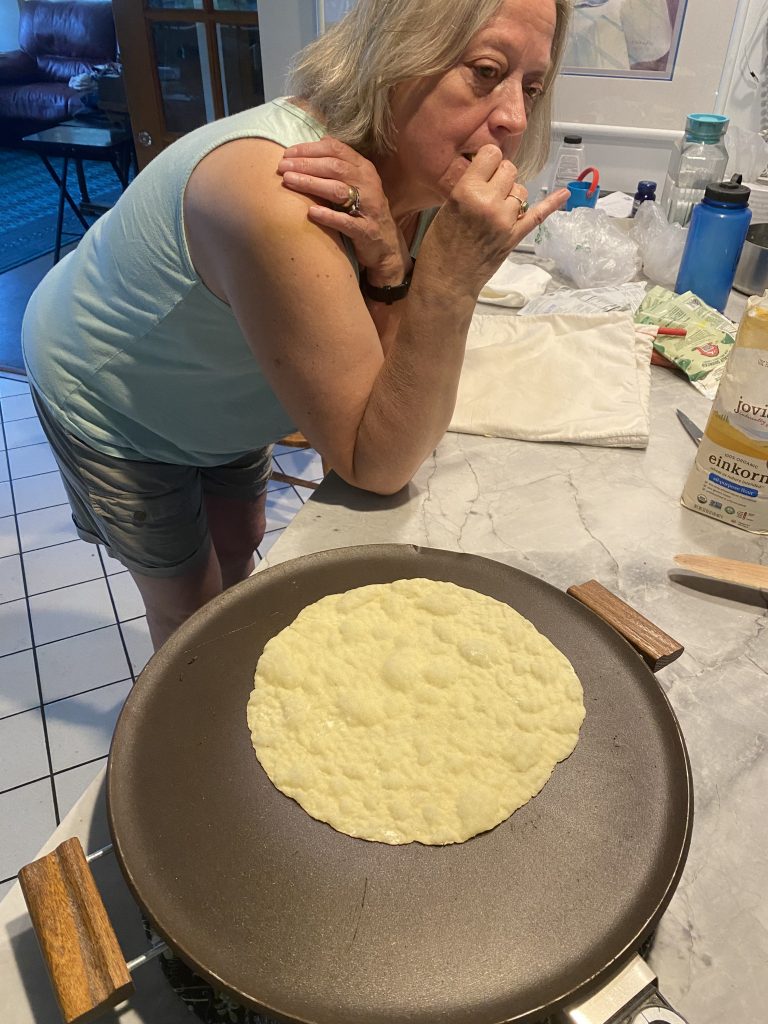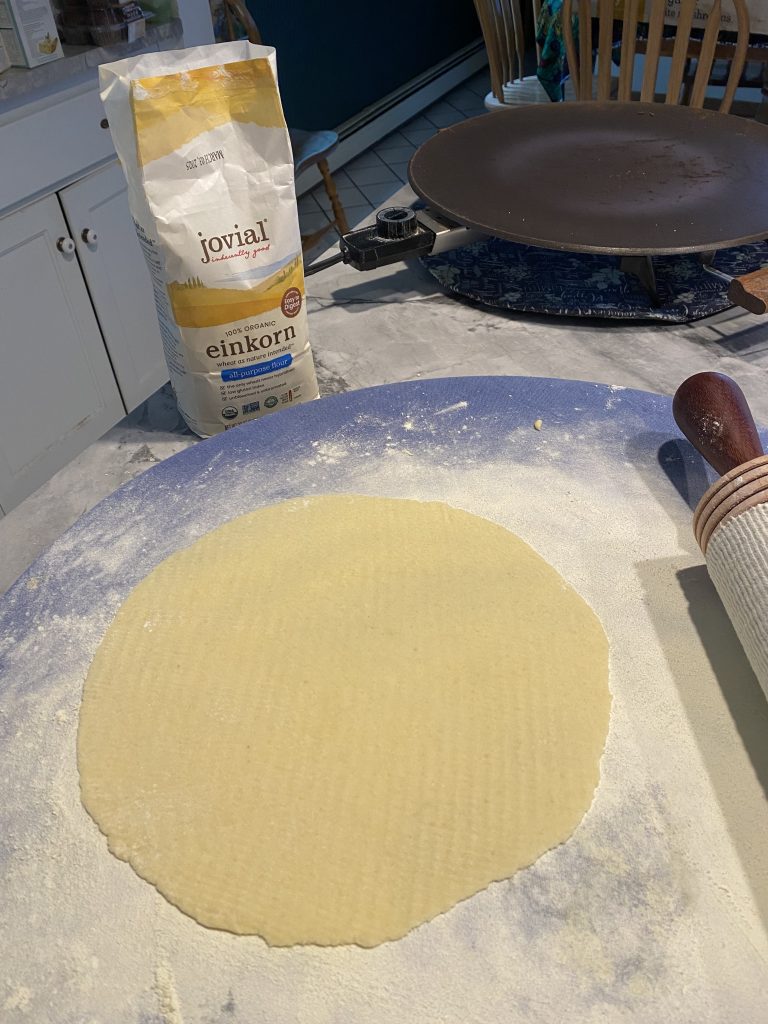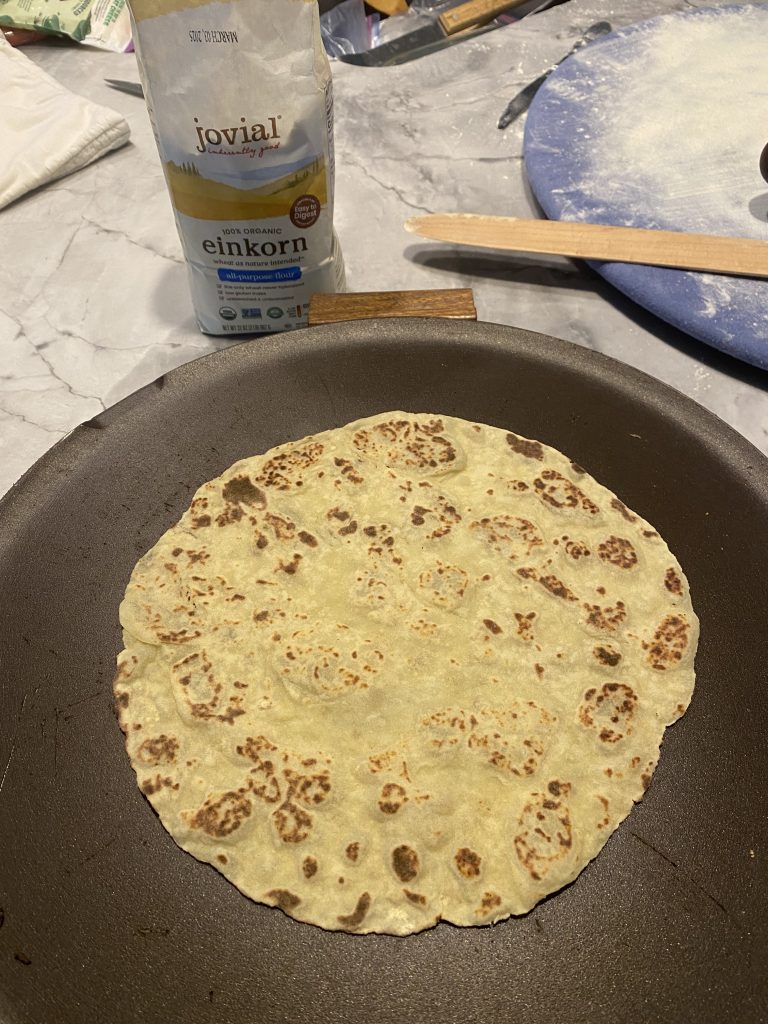
You know that old joke about the Norwegian who loved his wife so much that … that he almost told her? Well, two days ago I loved that Jane Legwold, my wife pictured above, could now eat lefse — good lefse — that I almost told her!
Actually, I did tell her how genuinely happy I was that she could once again eat tender, tasty lefse after decades of abstaining or eating crumbly, inferior lefse made with gluten-free flours. To these flours I would add xanthan gum in a effort to replace gluten and hold the lefse dough together as I rolled and baked. Often, however, the rolled out dough, which was a bit crumbly, never became a round round, just a jagged splat. And the round regularly fell apart in getting it to the grill, to the point that I had to use two turning sticks and a delicate touch to do the job. The end product rolled up and eaten fairly soon after making it passed as lefse, I suppose, and was a blessing to those who could eat that or nothing at Christmas.
The last time Jane and I were at both our local coop and grocery store, we found Jovial einkorn flour. You can also find it online. Jane had heard about einkorn. It is a wheat NOT recommended for those with celiac disease. However, for those who are not celiac but are gluten sensitive, which Jane is, einkorn can be a just the thing because it is very low in gluten. It is made of wheat that has never been hybridized and has tiny grains with less carbohydrates, more protein and a surprisingly sweet flavor. Here’s how it is explained on the Jovial website:
Einkorn has never been hybridized and contains the original 14 chromosomes while modern hybrids have 42. Over time, in an effort to increase yield to feed a growing population, wheat was transformed from this simple grain to a high yielding modern food source that was versatile and hardy. Einkorn does contain gluten but the proteins that make up the gluten in einkorn are short, weak and brittle and break easily when mixed with water. Einkorn has a very different ratio of glutenins to gliadins which are the proteins that make up gluten. This property has made einkorn easy to tolerate by many who find the strong, stretchy gluten of modern wheat flour impossible to digest.
“What Is Einkorn, and Is It Safe for Me?” on the Jovial website.
This all sounded too good to be true, but we bought the einkorn flour and I made a small batch of lefse dough with it kneaded in. I used my same recipe that I use for my regular lefse, but I simply subbed in the einkorn flour for the King Arthur all-purpose flour I normally use.
The dough was indeed sweet naturally and not crumbly. It rolled to make a round round. No jagged edges. I was encouraged. There were sticking issues, so I went extra light on the rolling pin and kept my rounds smaller than I normally roll, turning the rounds often in the rolling and moving them around my covered pastry board to prevent sticking. I also “sawed” my turning stick under each finished round to make sure the round was not sticking.

So far so good. Now getting the round to the grill. Using just one stick, I lifted the round and rotated the stick to flatten the round on the grill. No problem! My excitement grew.

On the grill, the lefse browned beautifully, and the rounds were tender and soft after cooling.
I tasted the einkorn flour lefse, and it was very good. Moist, tender, tasty — just like real lefse! I was jovial!
But I am not gluten sensitive. Jane is, and with hope but also some fear that this einkorn flour thing was more marketing than truth, she spread butter on the round and rolled it. She slowly ate the round, waiting for the signs of how gluten affects her: trouble swallowing, aching joints, foggy thinking and bloating.
Nothing. No symptoms as the hours passed and in the next few days.
We are wary still that with repeated eating of the einkorn flour lefse, symptoms will return. But maybe not, and this is a very good sign.
Again, this is not for people with celiac, just for those like Jane, who are gluten sensitive.
I get asked a lot if I have a gluten-free recipe, and I always have to say no. I have not found a gluten-free lefse recipe that I can get behind. They yield lefse that is just passable. But I am hopeful about einkorn flour lefse dough. It makes lefse that is more than passable. It’s pretty dang good!
